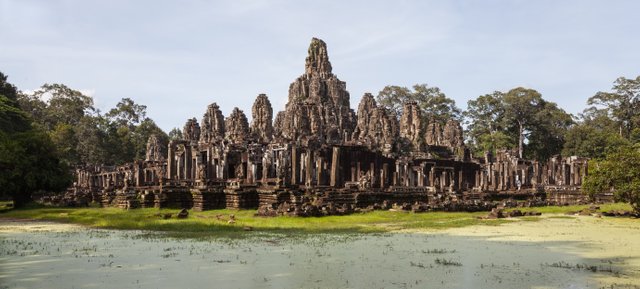Ankor Wat, Cambodia
Cambodia’s Angkor period is defined by the six-century rule of the Khmer Empire. The dawn of the Khmer civilization is the subject of an ongoing historical debate, but many scholars consider the reign of King Jayavarman II to be the impetus for a unified Khmer people. His kingship began sometime in the late 8th or early 9th Century when a Brahman priest named Jayavarman II the chakravartin, or universal monarch over Cambodia. Despite the celebrity of Jayavarman II in Cambodian history, the details of his rule are rooted deeper in the sand of legend and lore than in the firm soil of historical fact.

Following the obscure kingship of Jayavarman II, the Great Indravarman usurped the Khmer throne. Indravarman’s rule is characterized by the design and construction of a complex irrigation system, remnants of which still exist today. Under Indravarman’s rule, the young Khmer Empire began conceiving the trademark Angkor architectural style, identified by its strong devotion to Hindu and Buddhist religious concepts. Ingeniously, the Khmer irrigation system was used to embellish the Khmer temples in the form of gargantuan reflection aqueducts and water storage ponds. More than 1,000 years after the rule of Indravarman, we still use water to reflect our buildings, homes, temples, and monuments.
Indravarman’s son, Yasovarman, continued the work of his father, constructing some of the most important temple complexes of the Common Era. Yasovarman is identified as the inaugurator of the Phnom Bakheng and the Lolei Temples. Under his rule, the capital of the Khmer Empire was established in Angkor.
This site was inspired by Ara, our Siem Reap Tour Guide. She spent a couple days as our local guide and arranged for our tuk-tuk, for a temple guide and showed us around her city. If you are planning to visit Siem Reap, Contact Ara.
Building the Angkor Wat Temple Complex
From the rule of Yasovarman to the 12th century design and construction of the Angkor Wat temple complex, the Khmer people blossomed into the most significant religious, military, and social civilization in Southeast Asia. Their authority blanketed all of modern-day Cambodia, reaching into Vietnam, China, and across the Bay of Bengal.
King Suryavarman II is responsible for the construction of the Angkor Wat temple complex. He dedicated the temple to Vishnu, the Supreme God of Vaishnavite Hinduism, which remained its patron deity until the Cambodian people consecrated Angkor Wat to Theravada Buddhism in the 14th or 15th Century. Under Suryavarman II, the temple complex also served as the capital of the Khmer Empire and a strategic military post. Curiously, the original name of the temple remains unknown. Historians have not been able to locate any artifacts or inscriptions that refer to the temple complex by name.
The enormity of Angkor Wat was conceived and constructed with a level of precision and intention that continues to evade the modern mind. Some scholars believe that the temple complex was built to take advantage of Angkor’s water-rich agricultural potential. Other scholars attribute the construction of Angkor Wat to the Khmer belief in earth-star harmonization. The temple’s ground plan replicates the position of the stars in the Draco constellation.
Large portions of the Angkor Wat temple complex remain unfinished. Historical theory suggests that construction ended when Suryavarman II died. Regardless of why construction ceased, the temple’s unfinished status adds to Angkor Wat’s mysterious appeal.
Angkor Wat after the Khmer Empire
Since the fall of the Khmer Empire in the 15th Century C.E., Angkor Wat has remained one of the most significant religious structures in the world. Even after the Thais sacked the city in 1431, people from all across Asia continued to take religious pilgrimages to the ruined city, attributing its enormity and beauty to the gods of Hinduism and Buddhism.
The history of the Khmer Empire exists in the stone of Angkor Wat alone. Written inscriptions of the temple’s history, if they ever existed, have escaped modern examination. After the Thai takeover, Buddhist monks continued to preserve and uphold the sacred status of Ankgor Wat, but they overturned the original dedication of the temple to Hindu deity Vishnu. In Vishnu’s stead, the gods and concepts of Buddhism became the ruling principles of Angkor Wat.
In 1860, the French led an expedition into the heart of Cambodia attempting, inspired by the European hunger for exploration and discovery. Since the mid-1800s Europe and the West have been spellbound by the ancient city of Angkor Wat. The French pioneered an Angkor Wat restoration project in 1908 that continues to this day.
Source: siemreapcambodia.org/history/

Hi @frednoble, thanks for commenting on my comments. I visited your blog it is quite informative. I am also new steemians. As cheetah is upvoted to your post, According to my knwoledge Cheetah is bot by steemit which catches the copied content and upvoted that content which is negative sign for your steemit account. So please beaware of this next time. Your well wisher @cryptoexpert79.
Noted and thanks
Posted using Partiko Android